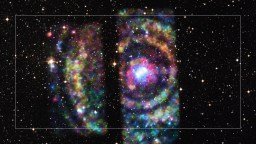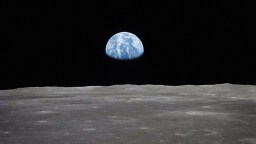MICHELLE THALLER: Ferran, your question is: When we have a permanent base on the Moon, where will the astronauts get air to breathe? I'm sure it makes sense to you that air is something that we consume and it would be a lot of effort to actually bring air tanks from Earth and actually launch them up onto the Moon.
One of the questions I can ask you is, where do you think the astronauts are getting air right now to breathe on the International Space Station? We don't actually take up giant tanks of air to the space station. They get it from water. If you run a very strong electrical current through water you can separate it into hydrogen and oxygen. Oxygen, of course, is the most important gas that we need to breathe. So the way the space station gets air is it takes water and breaks it up into those two gases and actually uses the oxygen for people to breathe. Now we could do the exact same thing on the Moon. And so your next question would be, well doesn't it take a lot of energy to bring water up there as well? We would have to bring all these water tanks.
This is one of the reasons we were most excited to find evidence of a lot of ice underneath parts of the Moon. Up by the poles of the Moon there are craters that are very well shaded from sunlight and they get very, very cold and we found evidence of more water in the lunar soil in those craters near the poles than we ever expected. That means if you had astronauts up there and you actually had the bases near the poles of the Moon there would be stores of ice and therefore water that you could actually tap into. You could actually turn that water into air for the astronauts to breathe without ever bringing anything up from the Earth. You could actually be independent on the Moon itself.
And there's another really important thing that you can make out of water by separating it into oxygen and hydrogen and that's rocket fuel. Rocket fuel today, liquid rocket fuel, is the combination of liquid hydrogen and liquid oxygen. So not only would you have air to breathe from the water, but you could make your own fuel. This is one of the things that we're investigating now, not only colonizing the Moon but also thinking about sending people to Mars. You send people so far away they have to be independent and they even have to make their own fuel to get back. And we think we can do that if we can find water.
One of the great questions is why would there be ice on the Moon? The Moon seems very dry, there's no atmosphere, how could there be water even frozen underneath the soil? Well, we think that what's happened over billions of years is that many different comets and asteroids have collided with the Moon. You can see all the craters on the surface. And asteroids and comets both contain a decent amount of water. Now, most of that water probably just got vaporized and flew off the Moon entirely, but some of it actually turned into ice. And the important thing about these deep craters near the poles is that they are shaded from sunlight. Sunlight would actually just disperse that ice and actually turn it into vapor, but in the dark, shadowy craters the ice accumulates over time and so you actually have a buildup of ice underneath the soil.






